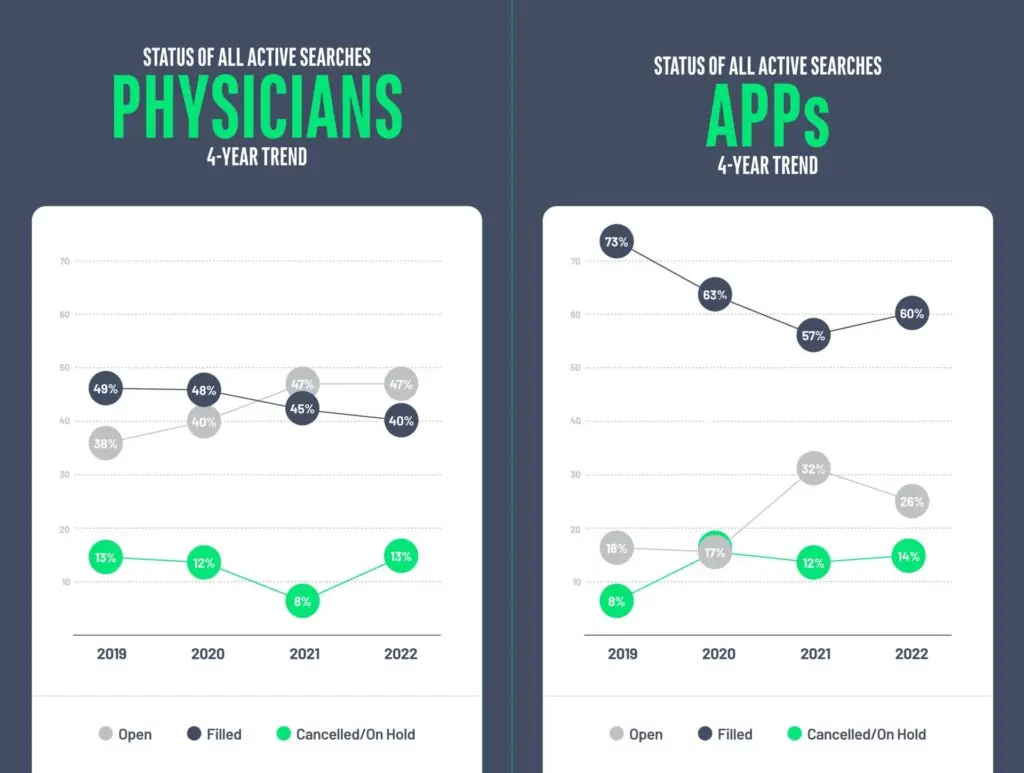The Association for Advancing Physician and Provider Recruitment’s (AAPPR) 2023 Annual Report reveals a notable shift— a decrease in the percentage of accepted physician employment offers. After several years of upward momentum, 2022 saw a drop in accepted offers from both physicians and advanced practice providers.
On average, advanced practice providers accepted 82% of offers extended to them, while physicians accepted only 71% of their offers.
Why are physicians accepting fewer offers? Here are some of the emerging healthcare trends that may be playing a role.
Healthcare providers have more options than ever, which means facilities need to be even more competitive.
When it comes to recruitment, the healthcare industry’s outlook has changed significantly over the past few years. Providers now have more employment options than the traditional models of hospital systems and private practices. Physicians are also recruited by insurance companies, private equity groups, urgent care centers, federal healthcare centers and clinics, and telemedicine groups.
Many providers are also moving away from full-time positions in favor of part-time roles like locum tenens, which offer greater flexibility.
With all these entities recruiting from the same pool, facilities must enhance their competitiveness to attract and retain talent.
Searches are taking longer to fill––which means that facilities have to fill the gap.

According to AAPPR, the number of successfully filled searches has steadily declined over the past four years, while job cancellations or indefinite holds have increased.
The longer a search remains open, the more likely it is to be abandoned or paused indefinitely.
This situation puts additional pressure on existing physicians and APPs to provide the necessary coverage, in a time when burnout is already a huge issue. According to Doximity’s 2024 Physician Compensation Report, 81% of physicians report feeling overworked, with 30% reportedly considering an early retirement.
What does that mean for hospitals? While competitive compensation remains crucial, healthcare facilities may need to offer more than just salary increases and incentives. Providing greater flexibility and reduced hours could make hospitals more appealing to providers seeking better work-life balance.
While open positions may take longer to fill, locums can help.
As long as we experience physician shortages, it is crucial to fill these staffing gaps and prevent existing providers from becoming overburdened and seeking opportunities elsewhere. But as any hospital recruiter knows, some positions just take longer to fill. Here are the top nine specialties that take the longest to fill, according to AAPPR:
- Cardiology: 192 days to fill on average
- OB/GYN: 178 days to fill on average
- Urgent Care: 165 days to fill on average
- Neurology: 158 days to fill on average
- Family Medicine: 153 days to fill on average
- Internal Medicine: 134 days to fill on average
- Hospital Medicine: 84 days to fill on average
- Emergency Medicine: 68 days to fill on average
- Anesthesia: 39 days to fill on average
That’s where locum tenens can help. For searches that are taking a longer, relying on temporary measures like locum tenens can help ensure that those gaps don’t end up negatively affecting the rest of your team.
Even if recruitment takes months, you’re not alone. A trusted recruitment partner can support your team throughout the search process, ensuring that while full-time staff coverage may have gaps—the quality of patient care does not.



